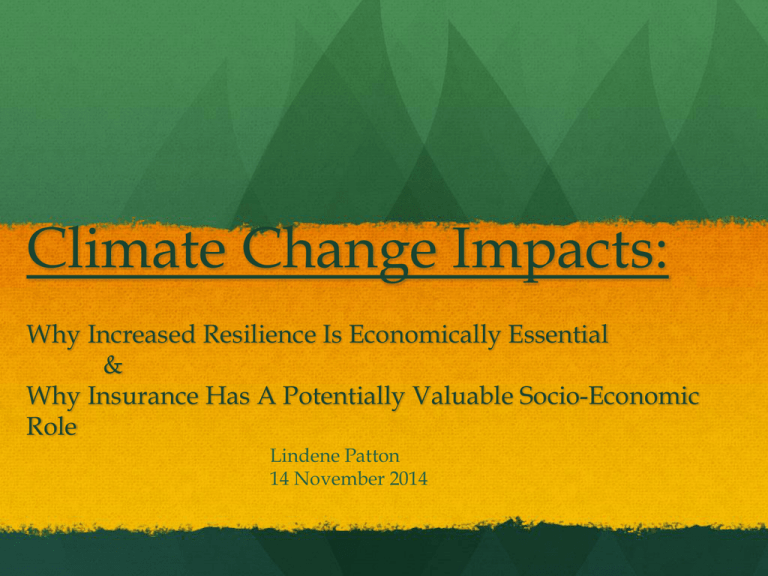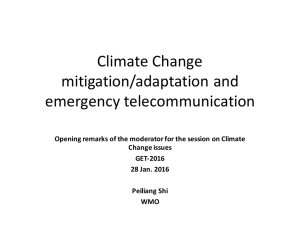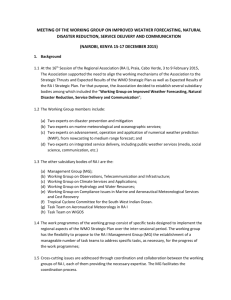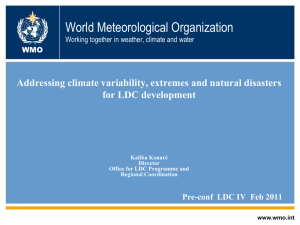
Climate Change Impacts:
Why Increased Resilience Is Economically Essential
&
Why Insurance Has A Potentially Valuable Socio-Economic
Role
Lindene Patton
14 November 2014
Disclaimer
The information in this publication was compiled
from sources believed to be reliable for
informational purposes only. All information herein
should serve as a guideline which you can use at
your risk. Any and all information contained herein is
not intended to constitute legal advice and
accordingly, you should consult with your own
attorneys when developing actions, programs or
policies. Neither the accuracy of this information nor
any results are guaranteed.
Climate Change …
What is climate change and how is SLR relevant ?
What does it mean for the insurance industry ?
Why is public policy relevant ?
What does it mean for customers ?
What does it mean to you ?
Why Innovation in Decision Support Analysis is essential and what’s happening in some areas
…
Climate Change v.
Climate Variability
source: US National Climate Assessment 2014
http://www.globalchange.gov/climate-change/whats-happening-why
What climate change means for
the insurance industry …
Increased severity of specific types of events
Loss of stationarity (water cycle is changed; rainfall frequency,
severity and location change)
Rate of loss increase is greater than asset value increase
Increased expectations / demands from customers
Temporal Dissonance between term of insurance instrument
(usually 1 -3 years) and ‘problem’ or ‘symptoms’ it seeks to
mitigate risk from (multi-decadenal)
Leads to rate making challenges with regulators and insureds
World Meteorological Organization (WMO)
and the Centre for Research on the
Epidemiology of Disasters (CRED)
WMO World Atlas Results
Breakdown by Number, Type & Decade
WMO World Atlas Results
Breakdown by Deaths & Decade
WMO World Atlas Results
Breakdown by Economic Damages and
Decade
Climate Change Impacts:
Loss
Ins
Worldwide Natural Disasters Losses 1980 – 2012
Billions USD
400
Global Nat Cat Losses (total)
350
Global Climate Related Losses
(total)
300
Global Climate Related Losses
(insured)
250
200
150
100
50
0
2000
2002
2004
2006
Derived from MR NatCatSERVICE data 2012
10
2008
2010
2012
Climate Change Impacts: Trends in
Federal Disaster Payment Ratios to
Total Loss 1992 – 2008
Cummins 2010 / 2013: Unfunded
Federal Disaster Response Costs
*Over 75 year horizon
2008 dollars
*Social Security: 4.7T
GAO
*Unfunded Federal Disaster Recovery Costs $1.1 T – 5.4T
Cummins (2010 / update 2013)
*Current US State Cat Funds
$3T USD underfunded according to
http://www.hawaiireporter.com/hurricane-sandy-pacific-tsunami-scare-expose-state-catastrophe-debts/123
Citing GAO-10-568R Natural Catastrophe Insurance Coverage GAO 2010
“Federal Financial Exposure to Natural Catastrophe Risk” J.David Cummins, Michael Suher, and George Zanjani (2010),
corrected.
12
CNT : Urban Flooding Report
for Cook County 14 May 2014
Documents chronic, repetitive
Flooding that is mostly funded by
disaster response – not insurance
13
The Challenge
Uncontrolled, accretive, off-budget disaster expense rising to level of
unfunded social security liability to the US Federal Government and US
Taxpayer
Current annual average cost - $400 per household
1.7-5.8T USD (Cummins et al)
Decreased insurance penetration relative to asset value
Government disaster risk management policies created when population
was primarily rural and capable of significant ‘self-help’;
Subsidize moving to the risk
Underprice risk
Decreasing investment in infrastructure
Population location shift: primarily to urban / coastal with specialized
labor – significant decrease in capacity to self-help
Public misunderstands purpose and14 extent of disaster response intent,
obligations and fund capacity of available government assistance
What is being done now ?
More study than action
DOE measuring resilience metrics for specific utility
classes
NIST resilience metrics
NIBS updating Multi-hazard mitigation Council
report
Actuarial Climate Risk Index (CAS and
SOA)(Updated Aug 2014 at NAIC)
Resilience metrics
Consumer / Commercial
Driven Applications
Now:
Current Image driven date
What’s coming:
Drone enabled imaging
Potential Impact
Exaggerated hail impact areas
Realistic hail impact areas
Wind: Sneak Peek
Lubbock, June 5, 2013
Wind Modeling
Lubbock, June 5, 2013
A Complete View From Point to Portfolio
©2014 CoreLogic®, Inc. All rights reserved. Proprietary and Confidential.









